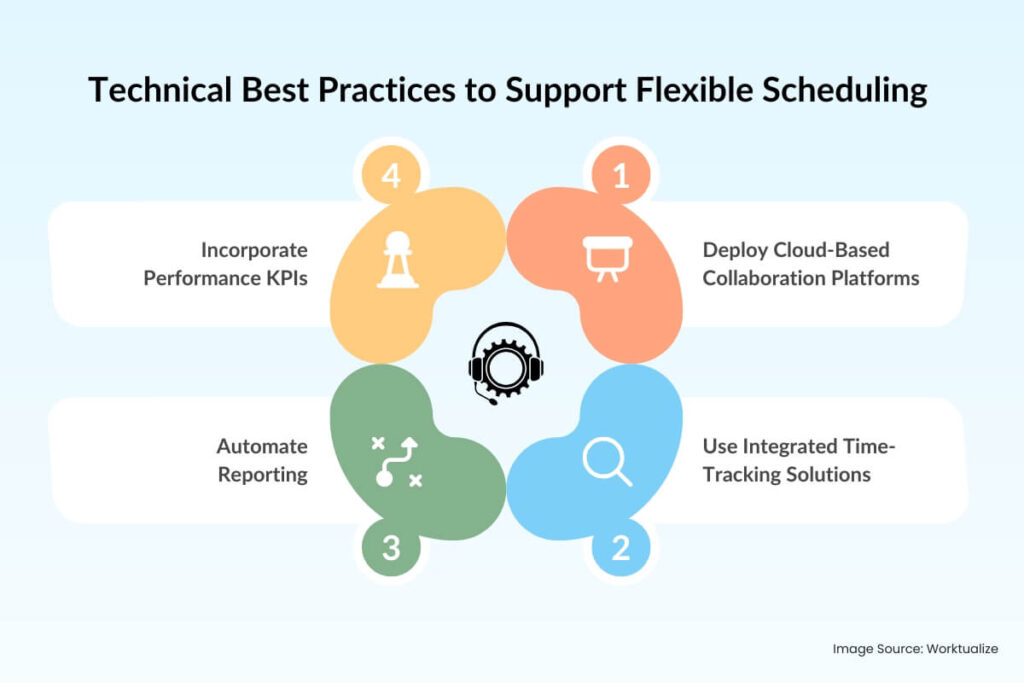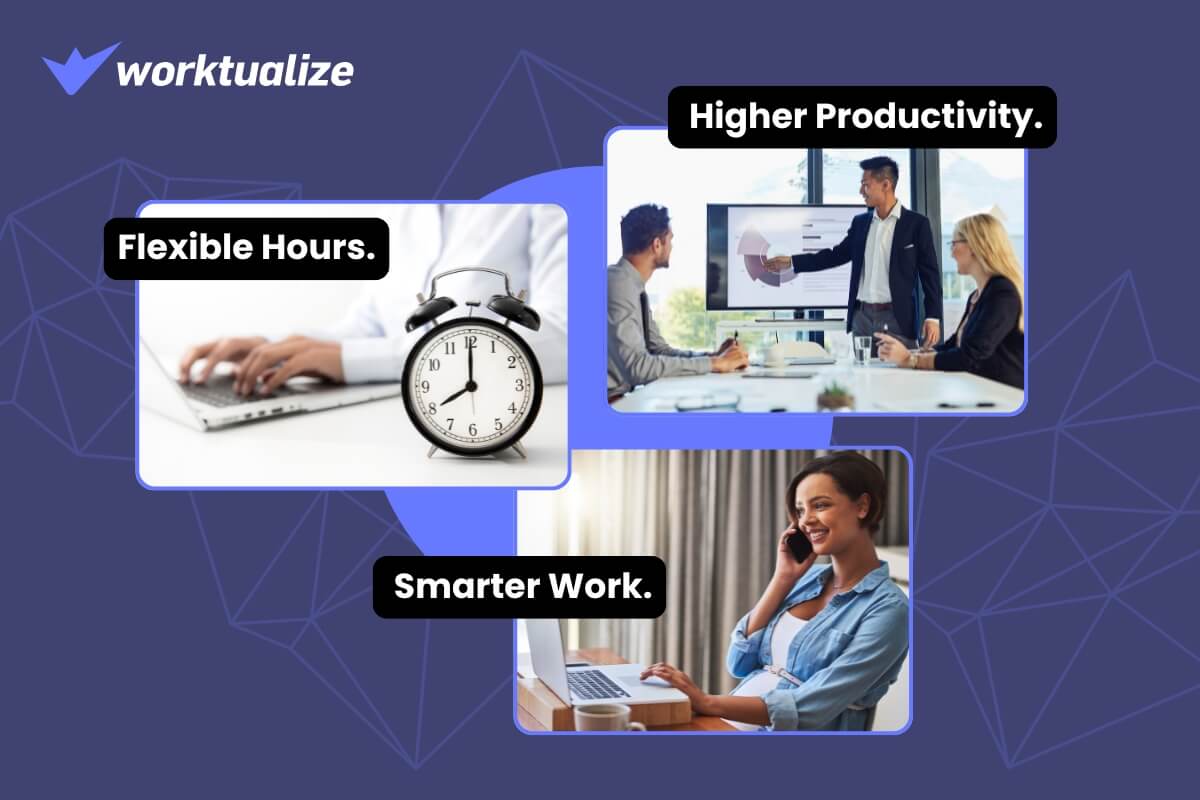In a business environment driven by output and results, traditional 9-to-5 work structures are increasingly being questioned. One of the most impactful shifts gaining traction across sectors is the adoption of flexible work hours. This model prioritizes performance over presence, allowing employees to work when they are most productive instead of being confined to rigid schedules.
Coupled with advanced employee productivity tools, remote work tools, and employee monitoring software, organizations can now objectively evaluate output and operational efficiency without being constrained by time.
This blog unpacks the concrete ways flexible work hours boost productivity, with supporting technical insights, examples, and the role digital tools play in making it work seamlessly.
Ready to manage flexible work schedules without losing control, visibility, or team focus?
Understanding the Core of Flexible Work Hours
Flexible work hours refer to work schedules that allow variability in start and end times. While some businesses may set core hours (e.g., 11 AM to 3 PM), employees have the autonomy to decide when to begin or end their day beyond that range.
Key formats of flexible scheduling include:
- Flextime: Employees choose start and end times but work a standard number of hours.
- Compressed workweeks: Employees work longer hours for fewer days.
- Split shifts: Employees break their day into distinct work blocks.
- Asynchronous work: Employees work independently of fixed hours or overlapping time zones.
This model works well when reinforced with robust employee productivity tools, allowing both employers and employees to maintain transparency, accountability, and clarity over tasks and timelines.
The Science Behind Productivity and Flexible Timing
Sources from Imperial College London reveal research in cognitive neuroscience that indicates that humans have varying circadian rhythms, meaning not everyone performs optimally during the same hours. Night owls tend to have higher cognitive performance in the evening compared to early birds. Rigid work schedules suppress this natural diversity, often forcing employees to work during their biological off-peak times, leading to diminished performance.
Organizations implementing flexible work hours allow individuals to align their peak mental states with task execution. Combined with digital remote work tools, this optimization creates ideal work conditions for employees to produce their best output.
The Impact of Flexible Work Hours on Output
1. Reduced Burnout and Absenteeism
Employee fatigue is a silent productivity killer. Long commutes, unaccommodating schedules, and lack of personal time compound stress and lead to higher burnout rates. With flexible work hours, employees have more control over their schedules, leading to improved mental health and lower absenteeism.
2. Higher Work Engagement
Autonomy breeds engagement. When employees are trusted to manage their time, they feel more valued and are more likely to be intrinsically motivated. This sense of ownership often results in superior task execution.
When integrated with employee productivity tools such as task tracking, project dashboards, and real-time updates, teams can stay aligned without enforcing rigid scheduling constraints.
How Remote Work Tools Support Flexibility
Remote work tools form the technological backbone of flexible scheduling. These tools enable distributed teams to collaborate, communicate, and execute deliverables without requiring physical proximity or synchronized timing.
Popular categories of remote work tools include:
- Project management platforms: Trello, Asana, and ClickUp help break projects into tasks with timelines, assignees, and dependencies.
- Communication apps: Slack, Microsoft Teams, and Zoom facilitate asynchronous and real-time communication.
- Time tracking software: Applications like Worktualize allow both employees and managers to quantify actual working time across tasks.
With the rise of asynchronous workflows, these platforms ensure work progresses without requiring simultaneous logins or instant replies. Such an environment supports deep work, minimizing interruptions and maximizing throughput.
Role of Employee Productivity Tools in Measuring Output
Transitioning to flexible work hours demands systems that shift the focus from time-based performance to outcome-based assessment. This is where employee productivity tools become indispensable.
These tools typically offer:
- Task completion tracking
- Project-wise effort logging
- Performance dashboards
- Idle time detection
- Goal vs actual comparisons
Using these metrics, organizations can make informed decisions based on real data rather than assumptions or subjective evaluations. Integrating employee monitoring software enhances this further, offering visibility into how work is executed throughout the day.
Why Employee Monitoring Software Doesn’t Undermine Flexibility
Some critics argue that employee monitoring software conflicts with the freedom that flexible work hours provide. However, the key lies in implementation. When used ethically and transparently, work monitoring tools can coexist with flexible arrangements, focusing on output, effort, and time utilization rather than micromanagement.
Looking for real-time insights while your team works on their own flexible schedule?
Key advantages of employee monitoring software in flexible setups:
- Quantifies idle vs active time
- Captures work patterns without requiring rigid schedules
- Enables real-time reporting and progress visualization
- Tracks productivity trends without invading privacy
When paired with open communication, these tools offer insights rather than surveillance, guiding employees and managers to make data-informed adjustments to workloads and schedules.
Measurable Benefits for Businesses
Implementing flexible work hours powered by digital productivity systems results in tangible business gains:
- Enhanced throughput: Employees working at their peak times complete more work in less time.
- Reduced turnover: Greater work-life balance lowers attrition and enhances employee loyalty.
- Operational cost savings: Remote-ready schedules reduce office space and utility costs.
- Faster project delivery: Asynchronous workflows ensure round-the-clock progress, especially in global teams.
When supported with remote work tools and employee productivity tools, these benefits compound, leading to substantial performance improvements.
Technical Best Practices to Support Flexible Scheduling
For organizations aiming to adopt flexible work hours successfully, a structured technical foundation is crucial. Here are a few critical implementation pillars:

1. Deploy Cloud-Based Collaboration Platforms
Cloud-first tools enable easy access to files, communication, and project updates across time zones. Choose platforms with integrations to centralize operations.
2. Use Integrated Time-Tracking Solutions
A platform like Worktualize offers synchronized tracking across employees and projects, allowing everyone to log work without time-based restrictions.
3. Automate Reporting
Manual data consolidation wastes time. Automating reports on hours, tasks, and productivity helps managers evaluate performance with accuracy and speed.
4. Incorporate Performance KPIs
Set clear deliverables and goals per role. Allow employees to meet objectives within their preferred timeframes, assessed through performance metrics rather than log-in hours.
Foolproofing Your Flexible Work Strategy: What to Avoid
Even with the right tools, flexible work strategies can fail if the execution lacks structure. Avoid these common pitfalls:
- No performance benchmarks: Flexibility is not a license for ambiguity. Define measurable outcomes.
- Lack of communication protocols: Misalignment occurs when there are no check-in standards or feedback loops.
- Over-reliance on manual tracking: Without proper employee productivity tools, managing a flexible workforce becomes guesswork.
- Ignoring employee input: Schedule autonomy must reflect personal working preferences, not arbitrary rules.
How Worktualize Powers Productivity in Flexible Teams
Worktualize is a cutting-edge AI-powered time tracking and performance tool designed for dynamic teams operating under flexible work hours. It bridges the gap between freedom and structure, offering precision-based insight without enforcing rigid oversight.
For Employees: Take Control of Your Time and Performance
Worktualize empowers employees to own their workday without being confined to rigid hours or micromanagement. Employees can effortlessly record their daily work hours, ensuring accurate logs that reflect actual effort. Whether you’re working on a single task or juggling multiple projects, Worktualize allows you to tag your time spent on each, giving you a clear view of where your energy is going.
You can also monitor your attendance, analyze idle hours, and review total working time—all from a centralized dashboard. This helps you identify when you’re most productive, giving you the insight needed to adjust your schedule accordingly. The platform also makes it easy to revisit specific tasks or projects to see exactly how much time was invested, reinforcing accountability and helping you optimize how and when you work.
For Managers: Monitor Without Micromanaging
For managers, Worktualize transforms oversight into insight. The platform allows for precise logging of each employee’s daily activities, including keyboard and mouse engagement levels that indicate real working time. You can view screen captures when necessary, track idle time, and assess productivity in granular detail—all without disrupting the autonomy that flexible work hours support.
Assigning tasks and monitoring their progress becomes significantly easier, thanks to real-time updates and performance tracking. The reporting feature simplifies management even further, allowing for the generation of daily, monthly, or custom-period reports with just one click. Managers get full visibility into team output, enabling data-driven decision-making while still honoring the flexibility that keeps employees engaged and productive.
Worktualize equips organizations with actionable analytics to balance employee freedom with accountability. Instead of micromanagement, it offers a structured pathway to optimize time, evaluate output, and empower team performance.
Increase Productivity, Adapt Flexible Work Hours
The adoption of flexible work hours is not a trend—it’s a response to a deeper understanding of human productivity and technological empowerment. When reinforced by the right combination of employee productivity tools, remote work tools, and employee monitoring software, this model transcends traditional limitations.
Employees get the autonomy they crave, while organizations gain visibility and control through data-driven platforms like Worktualize. The result is a work culture where efficiency, accountability, and satisfaction coexist, and productivity soars.
Flexibility isn’t the absence of structure. It’s a smarter structure—one built on trust, tech, and tangible results.
Work smarter with flexible hours, real-time tracking, and powerful productivity insights.
